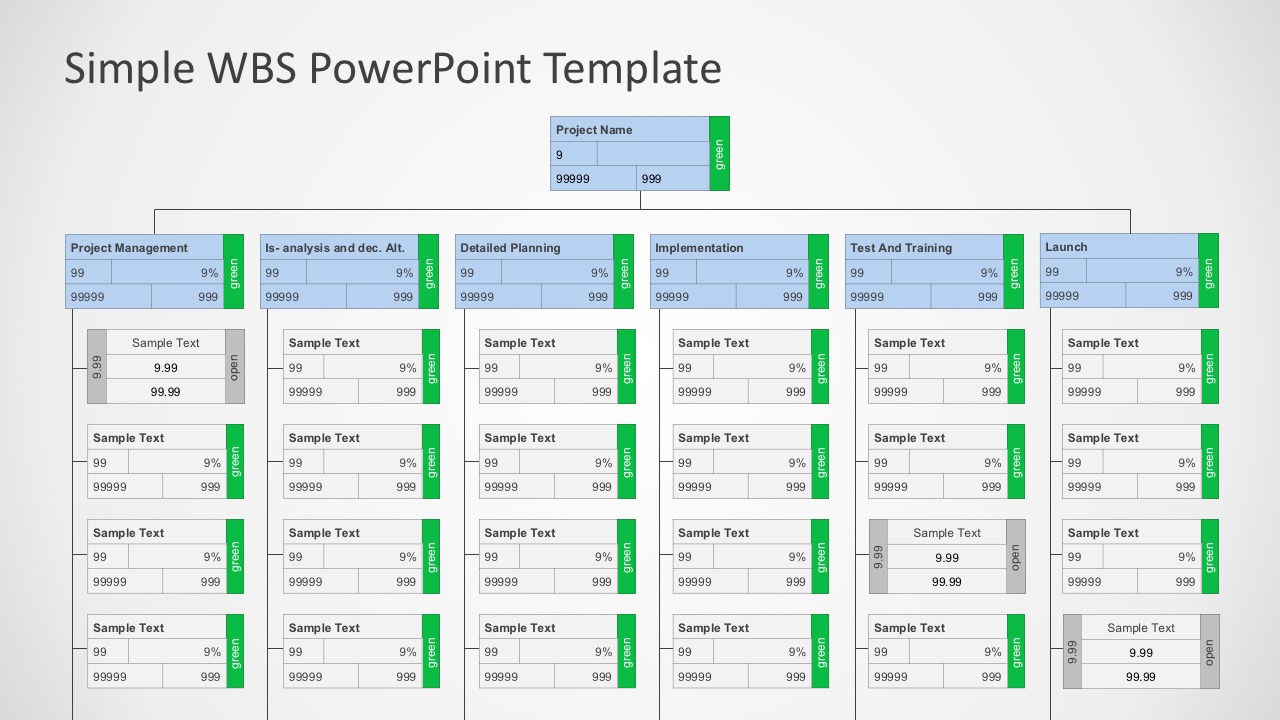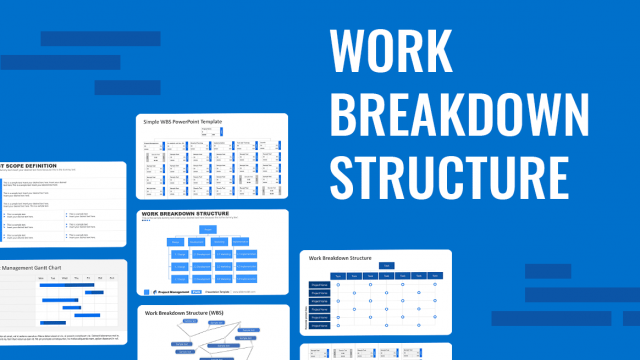
Projects that go over budget, take longer than anticipated, or go off the rails with change requests are every project manager’s worst nightmare. That’s why defining, presenting, and validating Project Scope is essential.
According to PMI’s Pulse of the Profession 2018, some of the leading causes of project failure are; changes in project objectives, inaccurate requirements gathering, inadequate vision or goal for the project, poor communication, and poor change management. Not surprisingly, all these situations are avoidable with a Scope Management Plan.
Defining scope at the planning stage and validating scope during a project lifecycle are two solutions to the general issue. Still, before starting a project at full speed, you need approval from stakeholders, and that’s where presenting the Project Scope comes in.
In this guide, we share the essentials of a Project Scope process and give you actionable advice on presenting scope effectively for stakeholder buy-in and approval. Plus, we explain how to turn 200-page documentation of a Scope Analysis into a Project Scope Statement, slide by slide.
Table of Contents
- What is Project Scope?
- Defining Project Scope
- Presenting Project Scope
- Validating Project Scope
- Managing Scope Changes and Avoid Scope Creep
- Case Study
- Conclusion
What is Project Scope?
Project Scope is an agreed-upon combination of activities and considerations necessary to complete a project. Without a clear scope assessment, a project can take forever to finalize, go over budget, or never finish. Scope, as part of the project management triangle — along with cost and time — is a critical and foundational process for projects of any size.
The concept of something being in and out of Scope is vital to understanding how scope works. When something is in scope, it’s considered and approved as a project deliverable or our assumptions about resources and budget. Things that are out of scope are exclusions to the deliverables list, requests from stakeholders that don’t fit the project’s objective, and any situation that might arise due to a change in available resources or changes beyond control.
The scope needs buy-in and approval from stakeholders before a project can kick off. For approval, the project manager presents the Project Scope Statement outlining the project objectives and boundaries and a work breakdown structure (WBS) highlighting the critical path to completion. How you present the scope is critical to stakeholder buy-in and approval.
After presenting the scope and upon approval, Scope Management starts. We can define Scope Management as the ongoing monitoring and assessment of the scope as the project progresses.

Who’s in Charge of the Project Scope and Project Scope Management?
The project manager is in charge of leading the Project Scope Management plan and execution. Project coordinators and schedulers support the Project Manager. During the scope planning stage, stakeholder roles are defined for scope validations and change request management.
Project Scope Management is an ongoing activity that spans the project lifecycle and should be present at every major stakeholder interaction. Stakeholder involvement in Scope Management and Change Processes leads to more effective projects. Ideally, every involved stakeholder should have some degree of accountability in the Project Scope management.
Why is Project Scope Management Important in Project Management?
Of all the things a project manager has on their mind at all times, scope is at the top of the list. Right next to the scope are time and cost. How much is that going to cost? Is it in the budget? Is this requirement in scope? Can it be ready on time? Project Managers regularly ask these questions about a project’s details, and some ask these questions for several projects simultaneously. The constant balance between scope, time, and cost is vital to quality deliverables and meeting project objectives and goals. It’s also essential for the project manager’s productivity and overall efficiency to successfully lead a team to project completion.
Scope’s relationship to Project Management is visualized in the triple constraint graph. This interdependent triangle visualizes how to deliver a quality project that meets stakeholder expectations on time and without critical over-budgeting. If one of the three constraints changes in any way, the other two must be assessed accordingly and need to change as well. There must always be a balance to avoid risks and complications.
Scope in and of itself is a great resource for project management, but it’s not without risks. A hazy and unclear scope will eventually show scope gaps where things aren’t clear on processes or stakeholder roles. An undefined scope can lead to scope creep, where out-of-scope features or requirements are added to the project without documentation and proper assessment. Finally, if not careful, the project can be riddled with gold plating, the practice of adding or adapting features to cover errors or gaps without proper planning and development under the scope umbrella.
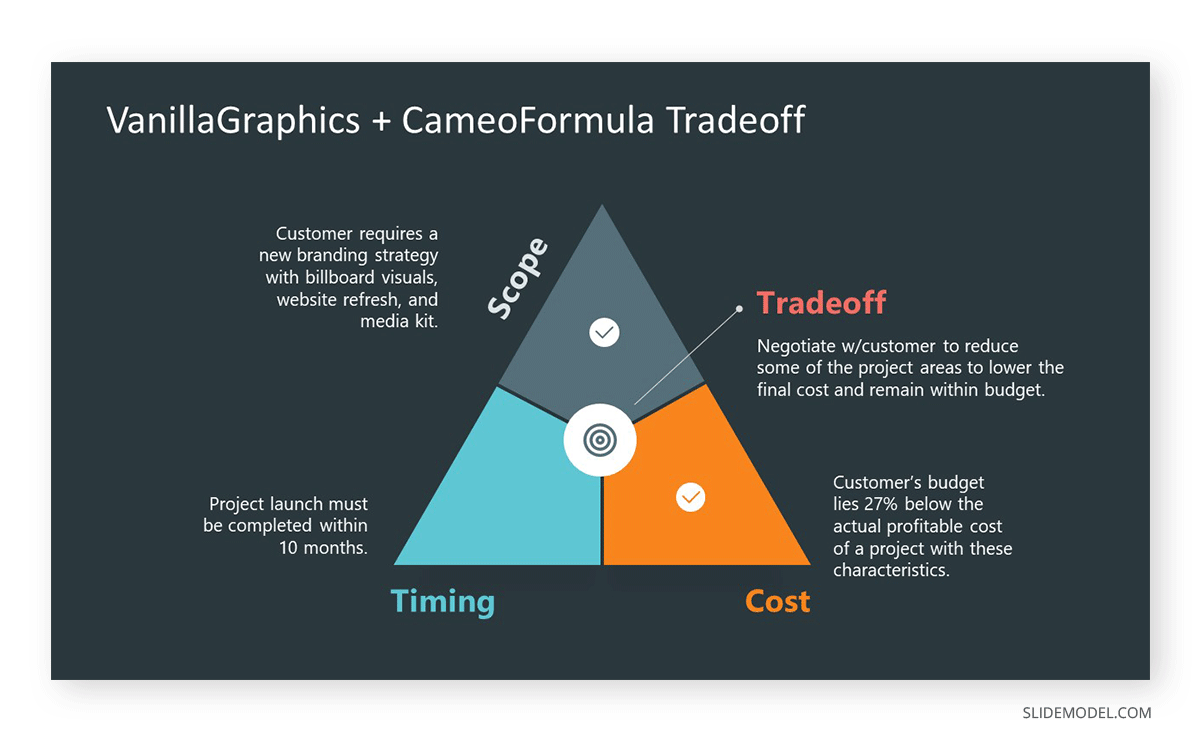
Defining Project Scope
After the scope planning stages that define stakeholders, requirements, and a scope management plan, it’s time to get to the nitty gritty and define your project’s Scope.
Defining project scope requires a scoping session or meeting with stakeholders with high buy-in. Stakeholders with lower involvement don’t need to be part of the scope management process but do need to be informed of it.
To define a project scope, use the key components as a map to guide you. Every step in the scope definition process aims to bring in and construct the critical components as the project scope foundation.
What are the Key Components of the Project Scope?
The project scope comprises a set of critical, non-negotiable components. These components will help define, manage, and present the project scope to stakeholders and participants. They are also the foundation for scope change management processes, as every component needs to be assessed when a change request comes in during validation.
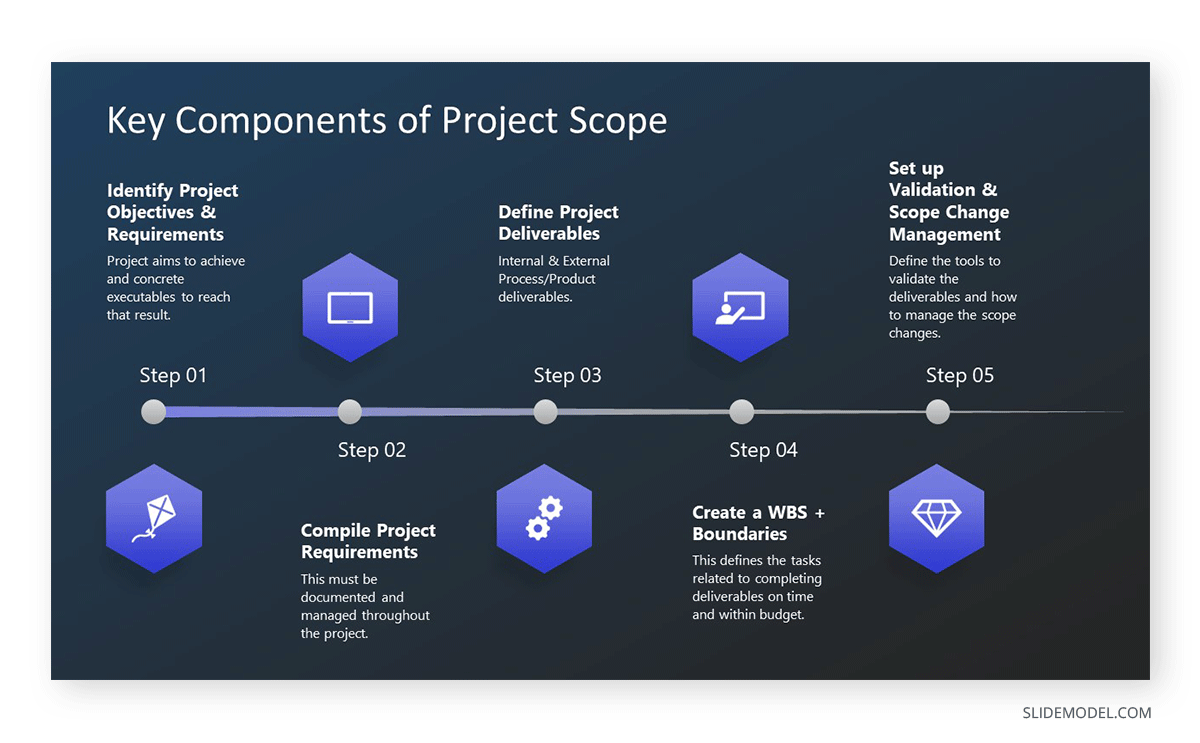
1. Identify Project Objectives
Clear objectives are critical at the start of every project. Not only do they direct the workflow during a project, but they also provide measurable input about the project’s success.
Project objectives are the results a project aims to achieve, while requirements are the concrete executable needs to reach that result. For example, suppose the project objective is to improve the quality of on-the-job training. In that case, the requirements are to build and customize a learning platform, improve the existing courses, and create new learning experiences.
According to The Project Management Body of Knowledge, Seventh Edition, “requirements are a condition or capability that is required to be present in a product, service, or result to satisfy a business need.” The business need is the project objective.
Organize the scoping session and start by defining the objective. Use the SMART goals technique to pinpoint specific, measurable, achievable, realistic, and time-bound objectives. Don’t continue to the next step in defining Scope until the objectives and how they’re worded are confirmed and approved.
Avoid vague expressions or unclear terms when writing the objectives and word them as statements. Objective clarity will help decide scope exclusions later. Be detailed with descriptive adjectives about time and capabilities.
2. Gather Project Requirements
With a clear set of objectives, it’s time to gather your project’s requirements from the stakeholders.
Requirements are compiled, documented, and managed throughout the project through requirement management upon initiation of the project, through the scope management process, and are a critical metric for scope validation.
- Business requirements are what the organization as a whole needs from project completion.
- Stakeholder requirements are the needs of all involved parties and project participants.
- Solution requirements are the overall functional and non-functional requirements to consider the project complete.
- Functional requirements are what a deliverable is supposed to do.
- Non-functional requirements describe how a deliverable should do what it’s supposed to.
- Scheduling requirements are all the ones that have to do with project timing and scope boundaries.
- Quality requirements are the checklists and processes needed for scope validation.
Improper requirements management can take a project off the rails. The list of project requirements directly affects the project deliverables’ positive or negative output.
According to research presented in Pulse of the Profession, carried out by the Project Management Institute (PMI), “a lack of clarity makes it nearly impossible to control scope creep. A continuous requirements improvement process helps establish the Scope of work to meet customer expectations. We see from prior research that erroneous requirements are among the top three reasons for project failure.”
Follow these steps to gather project requirements.
- Assign roles: Identify internal and external stakeholders. Build your stakeholder management process for this project and assign roles to the stakeholders.
- Interview stakeholders: Talk to the project stakeholders to find out what they want to achieve from this project and their goals to help take it to the finish line. Manage stakeholder expectations and be clear that not all their requirements will be included in the project.
- Gather and document: While conversing with stakeholders, document everything and analyze it to deduct the project requirements. Keep all documentation on hand for reference and regular updates. For large-scale documents, stakeholders can use automated document AI software for accuracy and precision.
- List requirements: Asses all the gathered information and special requirements that align with the project’s objectives. Define the individuals required to work on the project and draft a schedule showing how long the requirements will take to complete.
- Get approval: To ensure approval, ensure all requirements are necessary, specific, understandable, accurate, feasible, and testable.
To learn all the details about gathering and compiling requirements, read our guide on requirements gathering in the SlideModel blog.
3. Define project deliverables
Deliverables in project scope are all the tangible and intangible outputs that result from project deliveries. A deliverable list includes product and process deliverables for internal and external use. Create concrete lists of deliverables and label them in one of four categories:
- Internal Process deliverables are outputs like weekly time-tracking reports.
- External process deliverables include outputs like progress reports to stakeholders at the end of each phase.
- Internal product deliverables include outputs like an initial design draft or an article outline.
- External product deliverables are an app prototype or final website design.
Project deliverables are outlined in a work breakdown structure and scheduled using a Gantt Chart or another project management tool. To keep the project under control and in Scope, define one deliverable per requirement and arrange it below its relevant phase or control account. Deliverable shipping schedules can be at the end of every phase or through control accounts.
Deliverable shipping is generally timed along with the scope validation process. Creating a deliverables document leads to the validation process plan with a schedule, assigned roles, and a specific definition of what is considered done.
Write a clear and detailed checklist with all the characteristics of a deliverable to be considered as done, validated, and approved. The acceptance criteria must be decided upon together with all stakeholders on board. When these topics aren’t clear, confusion can arise during scope validation, and scope creep sneaks in quickly.
4. Create a work breakdown structure (WBS)
A work breakdown structure (WBS) is a visual, hierarchical deconstruction of project scope. It describes all the work necessary to finish a project, broken down into more minor, trackable activities. The overall function of a work breakdown structure is to define all the tasks related to completing project deliverables on time and within budget.
Visually, your WBS can be a bulleted list, an organizational chart, a tree diagram, or a Gantt chart. Let’s use a tree chart formation to examine the WBS components and levels in detail.
- Phases or control accounts: At the top of the chart are the project phases or control accounts, which are group deliverables organized chronologically or procedurally.
- Deliverables: From each phase or control account, stem out all deliverables.
- Tasks: For each deliverable, branch out all individual tasks or actions needed to complete it.
- Work packages: Groups of tasks that one person or team can do to reach a specific milestone in the project lifecycle
- Milestones: Optional metrics to include in your WBS to measure how tasks and deliverables are shipped. These are evident in Gantt charts, where tasks and work packages can be scheduled collaboratively.
- Tasks: For each deliverable, branch out all individual tasks or actions needed to complete it.
- Deliverables: From each phase or control account, stem out all deliverables.
Break apart the objectives and requirements with the work breakout structure to define all the tasks needed to complete the deliverables. An outline document is enough for small projects as a WBS, but any project with more than one objective and requirement needs more. You’ll need a visual structure that all relevant stakeholders can reference during the project lifecycle. A digital WBS in a Gantt or Pert chart will help visualize clear milestones and interdependencies between tasks inside a work package.
From your Work Breakdown Structure, build out a task plan. Make a task plan for each project phase and define the order and task dependencies. Organize and prioritize tasks with the help of a project management tool and integrate it into a schedule to visualize time requirements for each task. Show clear interdependencies to help define the project’s critical path — the longest sequence of tasks and activities needed to finish the project.
5. Set project boundaries and exclusions / What’s In and Out of Scope?
To successfully deliver a project, a scope assessment needs clear boundaries and exclusions highlighting what is in and out of Scope. Boundaries are based on the agreed-upon time, cost, and participants available per project phase and in total. Naming boundaries define the time a participant has to work on the project, the budget limit, and soft and hard deadlines. Exclusions are specific actions or outputs that the project will not work on and are the predefined out-of-scope characteristics.
Exclusions and out-of-scope requirements will always pop up during a project life cycle, and it’s the task of the scope management team to define if they stay out of Scope or if there needs to be a change to the overall Scope to include them. Avoiding scope creep is critical when defining what’s in and out of Scope.
An early definition of what is in and out of Scope helps control and manage scope creep before it starts. Along with a rigorous validation and shipping schedule, keeping a clear view of what’s in Scope or not not only helps a project move along more smoothly, it also takes it to completion in the allotted time.
Considering the project objectives, requirements, and deliverables, write a preliminary exclusions list to define the boundaries of where the line between in and out of Scope resides. Select and define which requirements discarded during the scoping session won’t be in this project scope. Do the same with the deliverables that didn’t make it to the deliverables list and add them to the list of out-of-scope deliverables.
Furthermore, consider the overall budget and time constraints to add clear boundaries to the project scope. Some projects need clearly defined physical and legal boundaries as well. Include this list in the project scope document when dealing with change requests and unvalidated deliverables.
6. Set up validation and scope change management processes
Before wrapping up the project scope statement, you must formulate processes to validate deliverables and manage scope changes. Having processes before you need them saves time down the line. The first process is for scope validation, and the second is for managing scope change.
For both processes, assign roles to stakeholders, participants, or project management assistants who will be in charge of conducting validation and control quality sessions and the ones in charge of receiving and managing change requests.
Define what constitutes the requirements for a deliverable to be verified before it can be validated, and set up a timeline that potentially matches the project phases. These are some of the tools and techniques you can use for scope validation processes:
- Activities to check the quality and functionality of the deliverables.
- Testing, inspection, demonstration, review, or audit, depending on the nature and complexity of the deliverables.
- Approval checklist
Presenting Project Scope
After defining the Scope for your project, you must share it with stakeholders to get buy-in and approval, especially from the ones that call the shots about money and time.
To present the project scope, take the — probably quite lengthy — project scope statement and turn it into a 30-minute presentation. Summarize the long text by pinpointing key details that stakeholders need to know and lay them out on presentation slides.
At the end of this guide, you’ll find a case study where we share how to present the project scope using a real-life example.
What is a Project Scope Statement?
A project scope statement is a document that shares the outcome of a scoping session and becomes the foundation of a scope management process. Throughout the pages of a project scope statement, you share all developed key components and other elements supporting your project scope assessment.
When do you present a project scope statement? Before starting any project. You need it to get stakeholder buy-in, support, time, and resources to reach the project objectives. To present a project scope statement, you need a project scope presentation.
Validating Project Scope
To know if deliverables are shipping as they should, you must conduct scope validation sessions that assess, verify, and approve the work as it’s being done. Validation isn’t a final step after project completion but rather an ongoing, repeatable process to follow and document.
What is Scope Validation?
Scope validation is the process in which deliverables are approved or declined by the customer or the stakeholder. Internal deliverables are validated by team members and managers in charge of approving or denying completion of the deliverable. The client or final user validates external deliverables.
When should you conduct validation sessions? At regular intervals during the project lifecycle. To keep processes aligned, schedule them according to the project phases. Follow the same process every time, record change requests or unapproved deliverables on time, and put them in the cycles or sprints as time and budget allow.
To validate deliverables, the people in charge of approving or not approving need to see all the relevant documentation about the project plan and the Scope. They must know the project objectives and have on hand the list of requirements plus the checklist that determines when a deliverable is done according to its characteristics. Likewise, they also must know boundaries and exclusions.
Managing Scope Changes and Avoid Scope Creep
As a project manager, you know that the only constant is change. No matter how tight your action plans and project scope assessments are, change requests always come in, and you must be prepared. The best way to be effective and cold-headed when facing change is to have a change management process.
Managing scope changes helps keep a strategic alignment, avoid cost overruns, and ensure timely project delivery. Not managing scope changes effectively leads to scope creep, the dreaded project management failure. It’s essential to have executive support in managing Scope and adapting to shifting business priorities. That’s why defining a scope management process that stakeholders agree on early in the project lifecycle is critical.
What is Scope Creep?
Scope creep is the result of unsteady scope boundaries in a project lifecycle. It manifests as client requirements coming in late in the project, stakeholders pushing back deadlines, change requests not following an identified process, and stakeholder confusion about scope boundaries.
Ultimately, scope creep hounds on employee morale and changes without foundation or proper planning make people stressed and uneasy. The risk of scope creep is always imminent unless you have processes to assess and manage out-of-scope requirements.
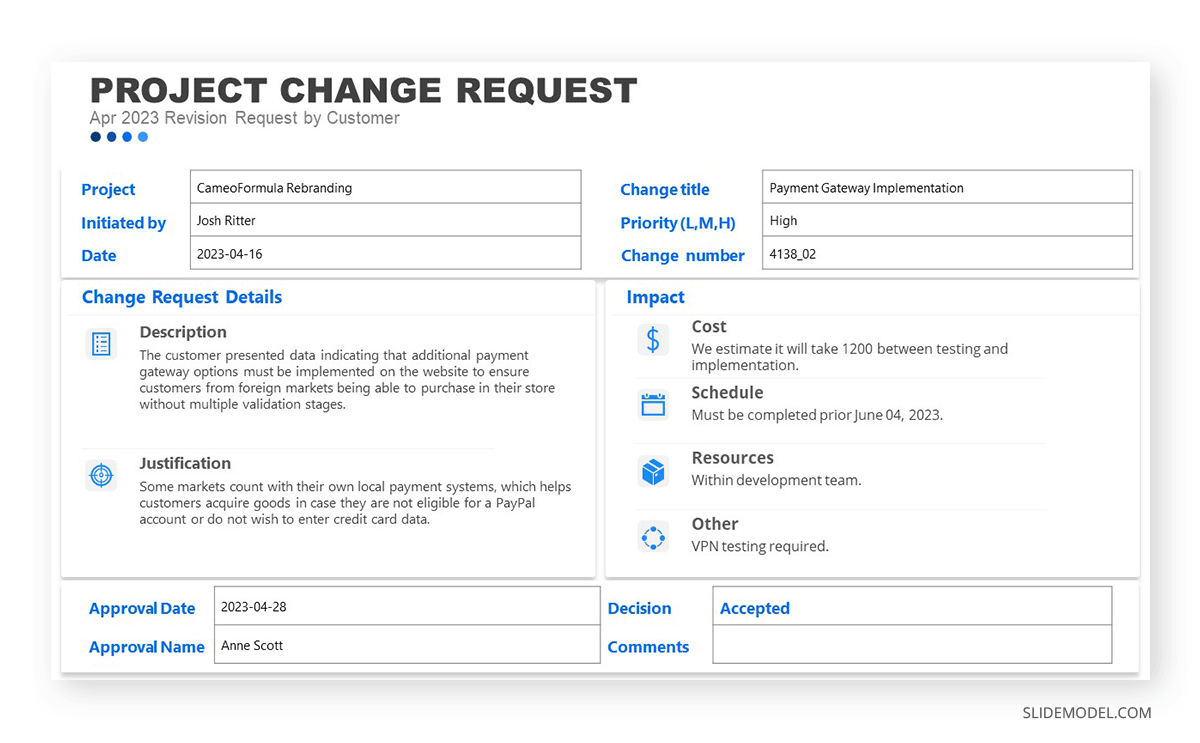
Case Study
A social media platform for small businesses wants to build a filterable analytics dashboard for its users with a set of basic metrics they analyze for their social behavior. The product team executed their requirements gathering process and built their requirements document. Later, all requirements were prioritized, and the Scope was defined following the process described earlier in this article.
After putting together a lengthy project scope document, the team must present the project scope using a pitch deck in order to get sponsorship, get approval, and kick off the project.
Let’s look at how the project team prepared their presentation.
NB: The slides used in this case study were designed using our Free Scope Presentation Template.
Executive Summary
The executive summary is the first slide introducing stakeholders to the project scope presentation. The objective of an executive summary is to:
- State the purpose of the presentation
- Highlight the key discussion points and most notable facts
- Relay any significant results, conclusions, or recommendations
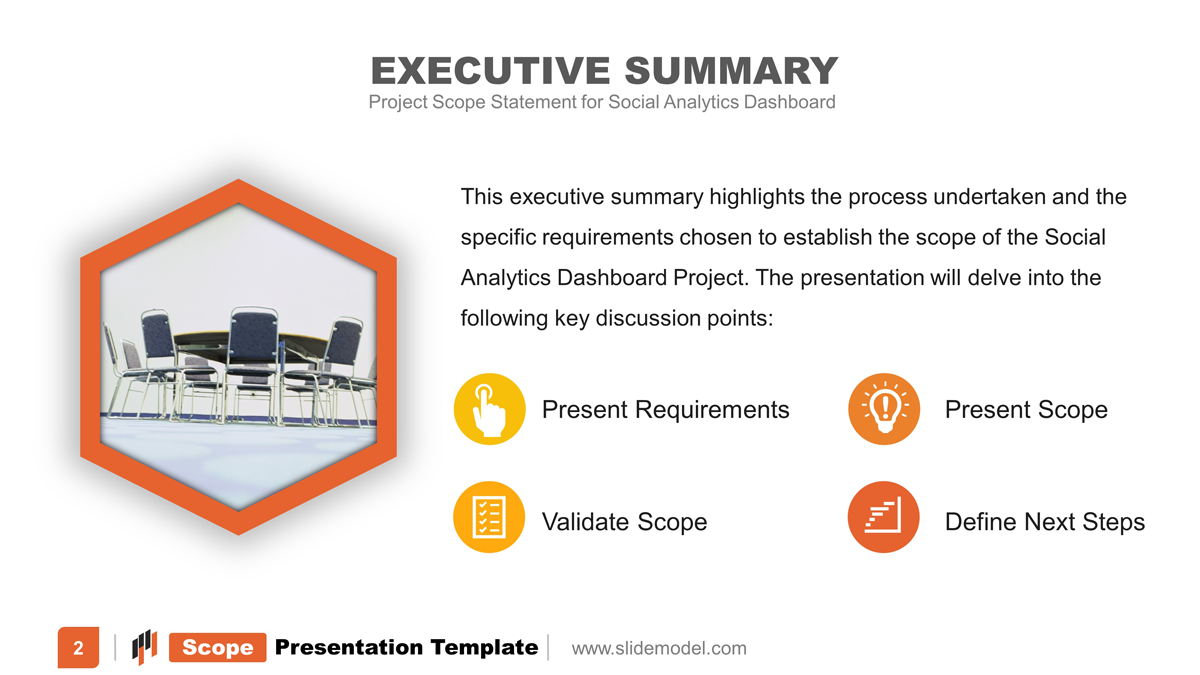
Following the summary you can present the agenda.
For our example project, we will follow a templated list of items to discuss a pattern of the industry.
- Project Objective
- Requirements Groups
- Deliverables
- WBS
- Scope Statement
- Exclusions
- Scope validation
- Scope change processes

To master your executive summary slide, read our complete guide on creating and presenting effective executive summaries.
Project Objective
This section sets the stage for the project scope, so it needs to be as clear as possible.
Use critical thinking techniques to clearly word, explain, and share the project’s goal and objectives. Frame the objective so stakeholders will see the value in the project and accept the Scope as you’ve assessed it.
Going back to our example project, the product team crafted the following paragraph to describe The project objective:
“Provide the users of our social media network access to summarized information of their social media activity (based on predefined KPIs) so they can measure and compare the performance of their content over a set of dimensions.”
This slide doesn’t need more information than the objective itself. Use contrasting colors like white text on a dark background or vice versa. Center-align the text on the slide, giving it a sense of importance. The overall project scope answers this objective, and it’s the North for all activities related to project scope management.

Requirements
After the requirements gathering and assessment process, the example project has over 50 requirements. In a scope presentation, reviewing each requirement and its details is unreasonable. Still, to transmit what is expected from the project and what will be the scope, the product team presents the groups of requirements using the project process grouping standard (Use Cases, User stories, Functional Requirements Documents, etc.)
Functional
- Requirement 1: Users will be presented with 2 KPIs to measure performance, compared against its value over date.
- Reach
- Number of Interactions
- Requirement 2: Users will be presented with the option to select the date comparison
- Last 7 days.
- Last 30 days
- Last Quarter
- Last Year
- Requirement 3: The user will be presented with the secondary dimensions they want the KPIs to be sliced (date will be the only primary dimension)
- Country
- Hour of the Day
- Type of Interaction
- Type of Content
- Requirement 4: Users will be presented with the option to download the report in Excel.
Visual
- Requirement 5:KPi’s Will be displayed on a dashboard screen
- 2 Numerical Indicators
- 2 Bar charts with date evolution over the X axis.
- Filters will be at the top bar of the screen with drop-down lists for filter selection.
Technical
- Requirement 6: Applications will be built in HTML-CSS, Using React.
- Requirement 7:Data will be extracted from the current Activity DB
- Requirement 8:Data will be pre-processed for performance.
The list of high-level requirements can be displayed in several slides, specifically for the example the presenter decided to break down each requirement group.
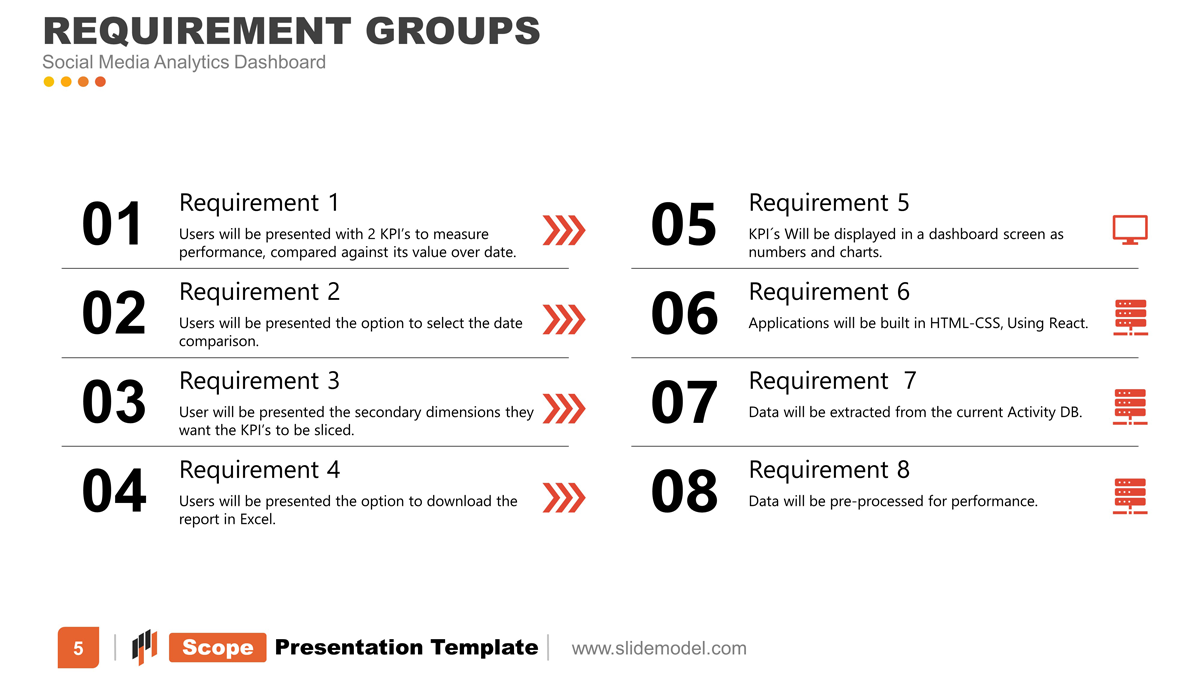
Deliverables
As described earlier in the article, Deliverables are the inputs and outputs for requirements. The requirement is part of a deliverable. In the project scope presentation, external and high-level internal deliverables are the most important deliverables to share.
Use a slide with a table layout to highlight deliverables per phase or control account. Incorporate labels, colors, or font differences to define which deliverables are internal/external process deliverables or internal/external process deliverables. Share any assigned stakeholder roles and points of contact between teams.
Architecture Deliverables
- Database design Diagram
- Architecture Diagram
- Integration Design Diagram
- Dashboard Mockups
Back End Deliverables
- Database Schema Implementation
- Batch Process To Load Database
- Service for Dimensions Population
- Service for Executing KPI Queries
- Reach Service
- Interactions Service
- Service to Export Information In Excel
Front End Deliverables
- Filtering Component
- KPI’s Numeric Component
- Overtime Charts
- Dashboard Screen
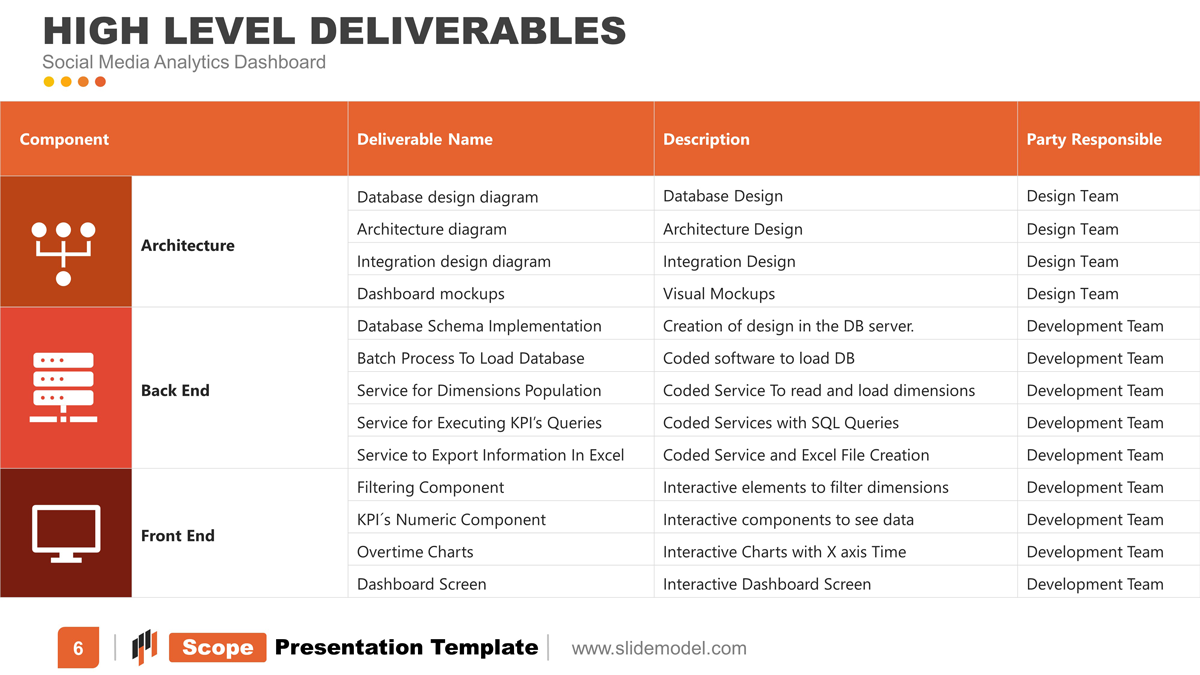
Work Breakdown Structure
Your complete work breakdown structure likely won’t fit on a presentation slide. Minimize it to include high-level topics and keep the full details in the project scope statement. Incorporate color coding to separate the WBS levels visually. Add labels for the stakeholders in charge of work packages and place notes for validation sessions at phases or milestones.
For the example under discussion, the project team broke down the work by high-level work area, as they will use a Cascade Model Process.
- Analytics Dashboard
- Analysis
- Data Analysis
- Analyse Activity Schema
- Define the Calculation of KPI
- Understand the Scope of the Calculation
- Functional Analysis of Requirement
- Understand Contexts of Use
- Discuss Users Scenarios
- Analyse devices
- UX Analysis
- Data Analysis
- Design
- Database Design
- ETL from Transactional DB
- Architecture Design
- 3 Layers Design
- Service Components
- Integration
- UX Design
- Usability and Navigation Definitions
- UI Design
- Design Layout
- Design Visuals
- Design Mockups
- Database Design
- Implementation
- Back End
- Database Implementation
- Data Access Implementation
- Services Implementation
- Facade
- Front End
- Implement Mockups
- Implement Navigation
- Implement Filtering
- Implement Query Calls
- Back End
- QA
- Test Back End
- Test Front End
- Test Integration
- Deplyment
- Deploy Database
- ETL Initial Data
- Deploy ETL Processes
- Deploy Application Server
- Package
- Deploy
- Deploy Web Package
- Deploy Database
- Analysis
As you can see in the example bellow, the presenter decided to showcase the WBS in different slides, going layer after layer in the explanation, instead of creating a cluttered diagram in one slide.

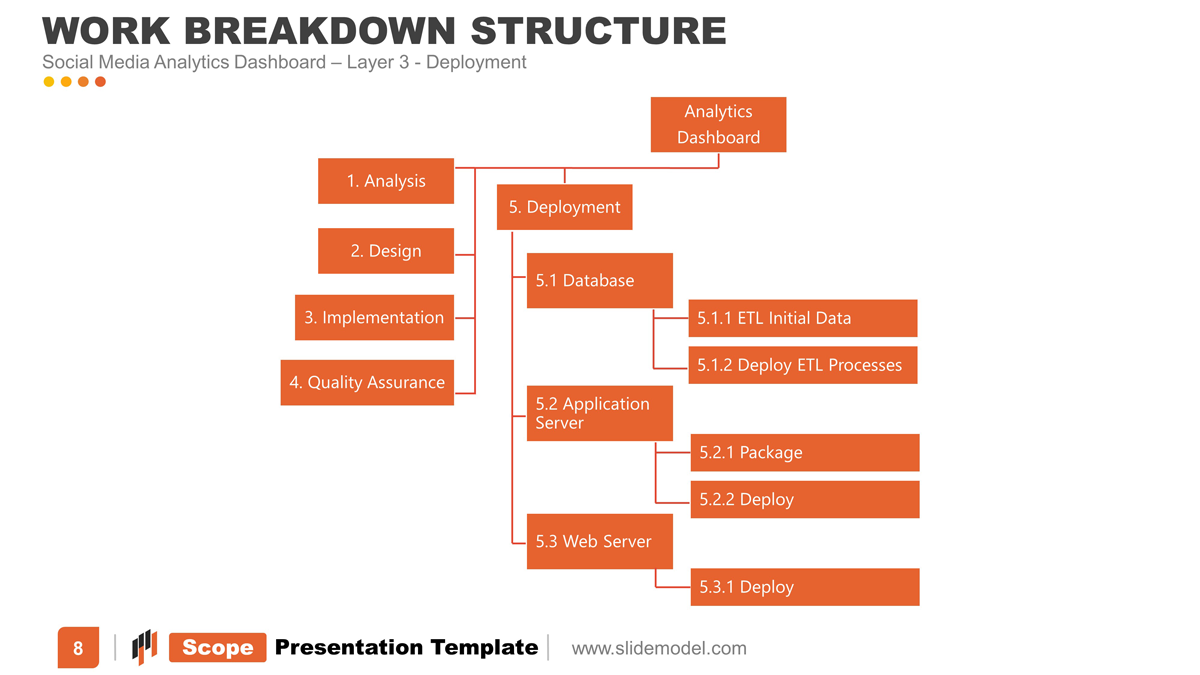
Scope Statement – Boundaries and Exclusions
In our specific example, the scope Statement lists the requirements that will be considered In-Scope and those that will be left aside for future iterations.
In-Scope: Requirements 1, 2, 3, 5, 6, 7
Out-Scope: Requirements 4, 8
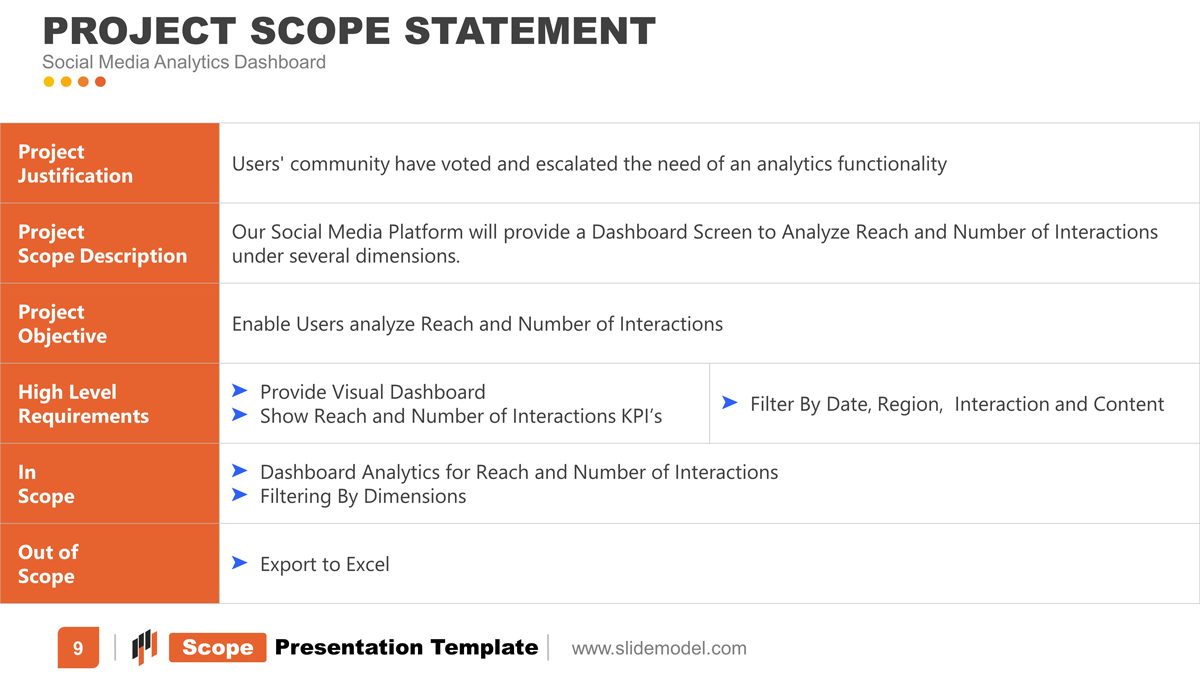
Validation Process
Once the project team defines the scope, it needs to be validated by specific stakeholders. Generally, even this scope presentation is part of the validation process.
The stages of validation of the current Scope are:
- User Validation
- Focus Group
- Prototyping
- Wireframes
- Feasibility Validation
- Plan Activities
- Create Estimations
- Simulate Resource allocation
- Executives Validation
- Present Scope to PMO
Scope Change Plan and Management Process
The final slides on the Project Scope Presentation share the planned processes for Scope Change. In this specific example, the Project Team decided to follow this process:

FAQs
Who is responsible for managing the Project Scope?
The Project Manager leads the Project Scope Management process, supported by project coordinators and schedulers. Stakeholders also play a key role in validating Scope and managing changes.
What is a Project Scope Statement?
A Project Scope Statement is a detailed document that outlines the project objectives, requirements, deliverables, exclusions, and boundaries. It serves as the foundation for Scope Management and stakeholder alignment.
What is Scope Validation?
Scope Validation is the process of ensuring that deliverables meet the agreed-upon requirements and are approved by stakeholders. Validation is conducted at various project phases, not just at the end.
What is a Work Breakdown Structure (WBS)?
A WBS is a visual representation of the tasks and activities required to complete a project. It breaks the project into smaller, manageable components organized hierarchically.
How are boundaries and exclusions defined in Project Scope?
– Boundaries: Specify time, budget, resources, and constraints for the project.
– Exclusions: Clearly list tasks, deliverables, or requirements not included in the Scope to manage expectations and avoid scope creep.
Can a poorly defined Scope lead to project failure?
Yes, a poorly defined Scope can result in:
– Unclear project direction and objectives.
– Scope creep and cost overruns.
– Delays in project completion.
– Reduced stakeholder satisfaction and project failure.
Conclusion
Project Scope holds a high bar for ensuring project success in project management. Attaining complete stakeholder approval of a Scope Management document is essential for every step after project initiation.
In this guide, we reviewed all the basics of Project Scope and actionable guidance on presenting a Scope Management slide deck to get approval from stakeholders. All the slides you need for a Scope Presentation are available as PowerPoint templates inside the SlideModel template library.
